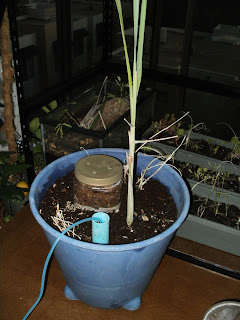So, you are thinking about creating an indoor garden. What is the first thing to get figured out? As I have mentioned before, the most important thing to remember about gardening is that you don't take care of your plants. You take care of your soil, and the soil takes care of the plants. As with most people, you are probably going to want to start with a nice high-quality bag of potting soil. Don't. Just don't. I mean, sure, if you really can't wait and just have to get started now, go ahead. But making quality soil doesn't take all that long, and it is the cornerstone of a good organic garden.
The question is, how do you avoid the mess, smell, and bugs that come along with indoor composting? Well, it isn't going to be easy. Sure, there are plenty of units out there to buy, but where is the fun in that? So let me tell you about the one I built.
The first thing to keep in mind is the challenges. That is the start of any engineering project, after all. Start with your challenges and your constraints. The challenges are keeping the smell to a minimum and not attracting pests while still getting some serious rot going on. The constraints are that it is going to happen in a living space in a small container.
First of all, I started with a nice, big pot with no drain. You really don't want the leachate sitting in a tray, and you REALLY don't want it overflowing and puddling on your floor. Plus, it will attract pets and pests and that is to be avoided. So let's contain that mess. However, you need to deal with it somehow. Otherwise the nutrients will puddle at the bottom and stagnate in the water that isn't going anywhere.
Or is it? As with my mushroom projects, I want the moisture to stay around long enough to do some good, but I still need it cycled out. So what is going to pull that moisture out of there for me and dispose of it? In case you are unfamiliar with this blog, I am going to use biological action. In this case, a plant will do nicely. I need something that will be tolerant of lots of water and a very, very fertile soil. It also needs to use a lot of water, as you want that water cycled out of there. Food production is also a nice byproduct. I used lemongrass. As one nursery employee described it to me, it is a pig of a plant. It will take all the water and fertilizer you can give it.
However, the plant needs to be separated from the compost. If you don't do that, you have no way to collect or add your compost. For that, a smaller container nested inside your pot would be perfect. Terra cotta with a lid would be ideal, but finding the right size might be tricky. I used a tall, fairly narrow plastic container I bought dried mushrooms in. A few small holes in the top gave it a little ventilation and a few large holes in the side allowed water and nutrient exchange. I just dropped it in the pot and filled the outside with soil. On hindsight, I think I might have filled it with wood chips. It will make the plant struggle a little at first, but the wood chips would have helped moderate some of the smell and absorb some of the excess nitrogen if you got your green/brown mixture wrong.
Okay, so you have your plant in place and are ready to start filling in your compost. How do you proceed next? Well, first of all, remember your green to brown ratios for compost. Those are important here. If you dump a ton of green in there, it is going to smell and there is nothing you can do about it. So make sure you put enough paper towels and stuff like that in there. And keep that lid on. It keeps out the fruit flies and keeps most of the smell contained.
What about worms? Can you put worms in there? I did. The thing to remember about worms in containers is that if they run out of food or get bored, they sometimes go for an adventure and you will come across their little desiccated corpses laying on the floor. To me, it is worth it. They process the compost faster than bacteria alone and really help keep the smell down.
The biggest problem I ran into was impatience. I made myself a nice fruit salad one day and couldn't bear to part with the compost. So I stuck it in the blender and made a nice slurry and poured it in. Don't do that. It filled all the little holes normally occupied by air and made the whole thing smell like dirty diapers inside of two days.
For maintenance, just add stuff as the level drops and water regularly. The water pushes out the bad air as it passes through and allows fresh air to enter when it is past. When it gets close to being finished, just stop adding stuff for a while and let it finish. Then scoop out the black gold and start filling again.
Saturday, August 31, 2013
Subscribe to:
Posts (Atom)

